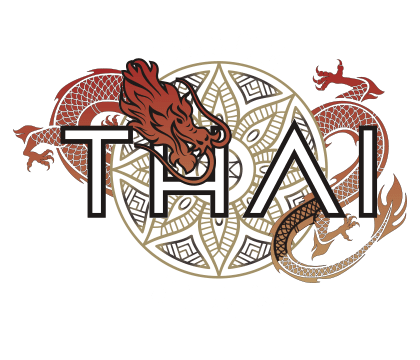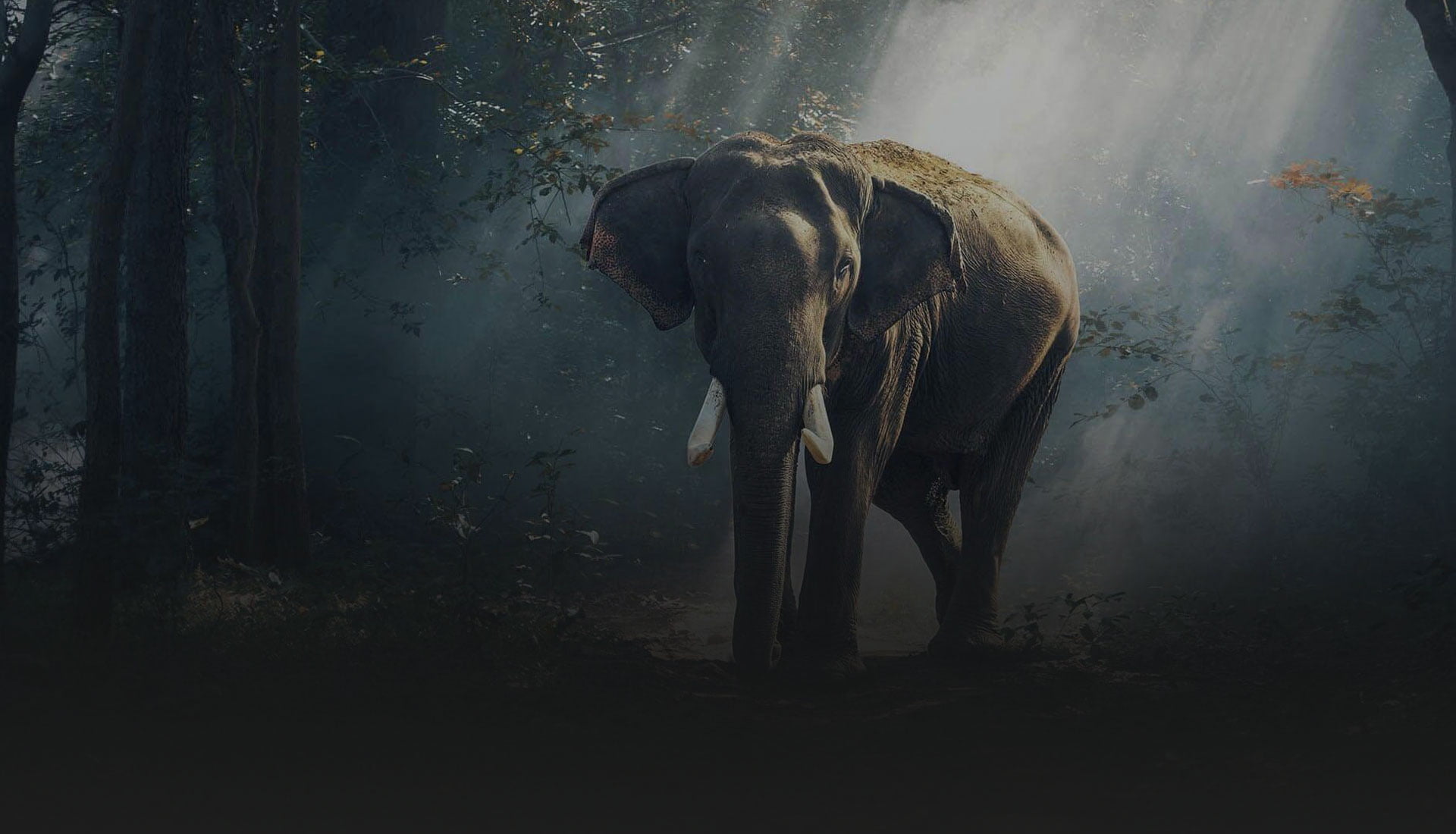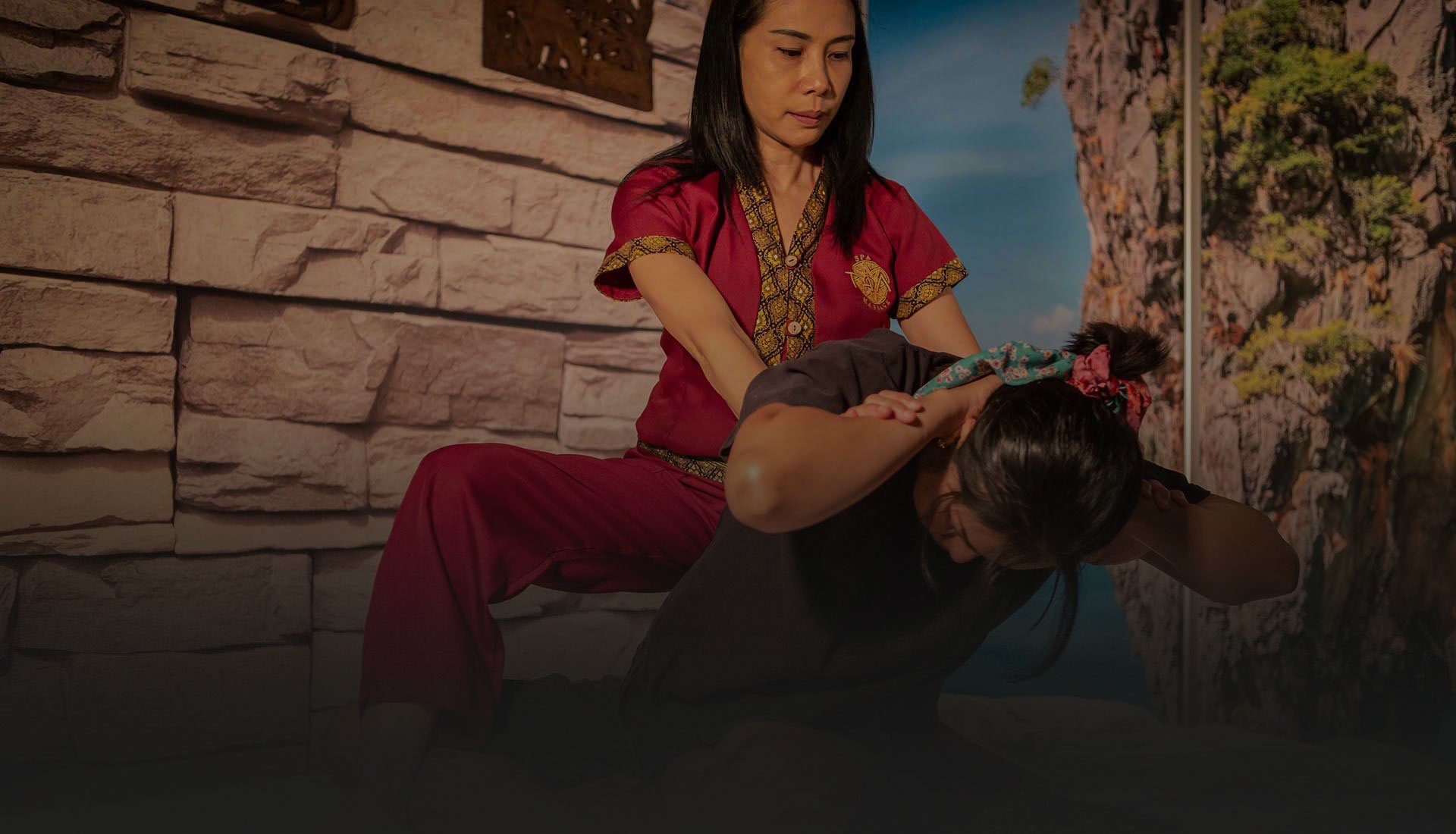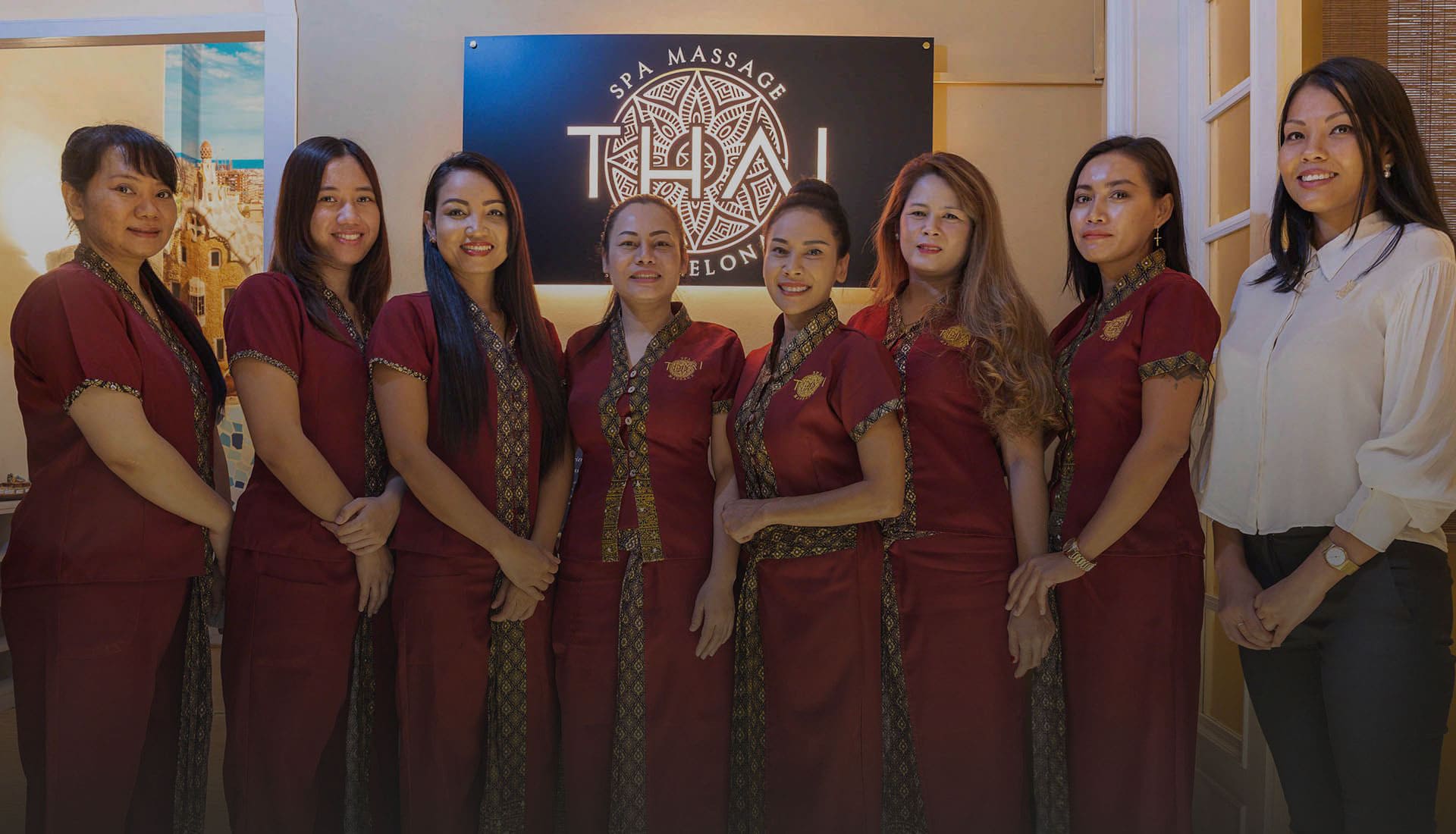The temple of the emerald buddha, in Bangkok , is an emblem of Thai faith and art. Home to the revered image of Buddha, this site combines spirituality with impressive architecture
Visiting the Temple of the Emerald Buddha in Bangkok is a must when traveling to Thailand. First, for its exceptional size and beauty, located in the Grand Palace of Bangkok, inside the Phra Kaew Temple. Second, for its fascinating legend and historical impact, which make this place a fundamental element for Thai identity. This emerald Buddha is also considered the guardian of Thailand and represents a national icon.
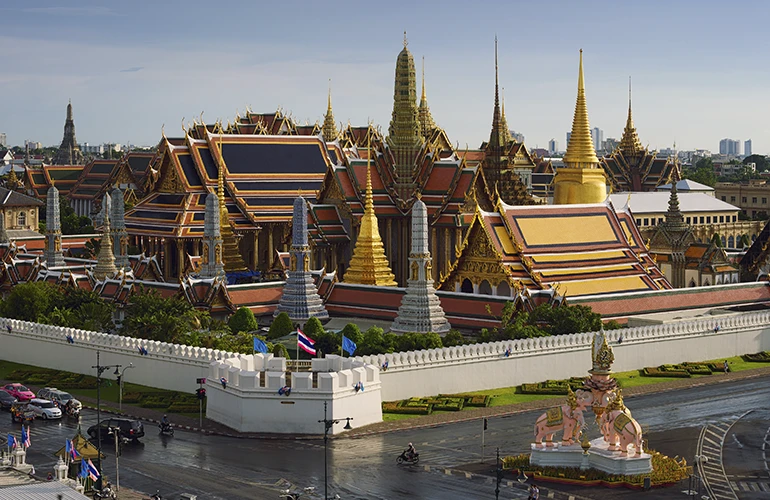
Exterior location of the Temple of the Emerald Buddha, Bangkok, Thailand.
Where isthe Temple of the Emerald Buddha located?
This sacred sculpture, housed in the Phra Kaew Temple, within the precinct of the dazzling Grand Palace of Bangkok, not only captures the eye for its impressive beauty, but also weaves a rich tapestry of mysticism and legend that embraces the heart of Thai culture. Phra Kaew Temple, also known as the Temple of the Emerald Buddha, is located in the heart of Bangkok, Thailand, within the Grand Palace complex. This temple is one of the most sacred and visited places of Buddhist worship in Thailand.
Built in 1782 by King Rama I, founder of the Chakri dynasty, the temple was established to house the sacred Emerald Buddha, a symbol of protection and power for the monarch and the country. This location within the Grand Palace, the official residence of the kings of Thailand, underlines the indissoluble union between the Thai monarchy and Buddhism, reflecting the king’s role as the main protector of Buddhism in Thailand. The presence of the Emerald Buddha in this place is not only a reminder of the country’s religious devotion but also of its rich history and culture.
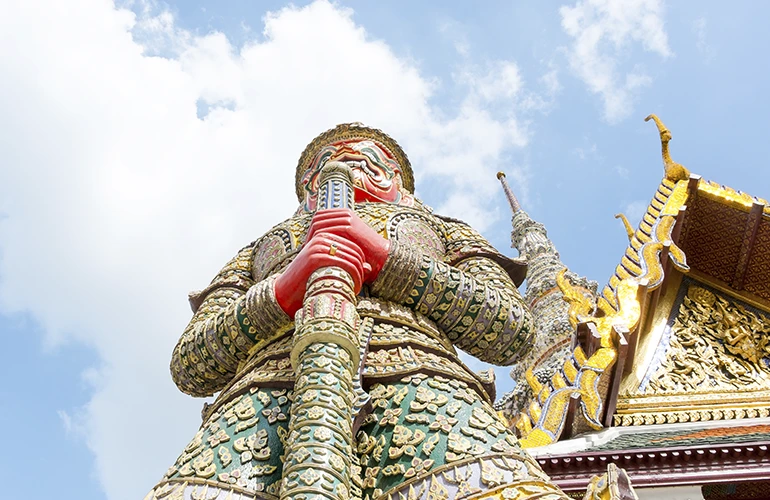
A giant statue of a Yaksha in the Grand Palace, Temple of the Emerald Buddha (Wat pra kaew) in Bangkok, Thailand.
What is the significance of the Temple of the Emerald Buddha?
Well, it has a deep spiritual, cultural and historical meaning for Thailand, representing the very essence of Thai identity. Every detail of the temple, from its mosaics and murals to the ornate buildings that surround it, reflects the country’s rich cultural heritage and its deep connection to Buddhism. Over the years, the temple has been a symbol of the nation’s continuity and stability, surviving political and social changes and serving as a rallying point for the Thai people.
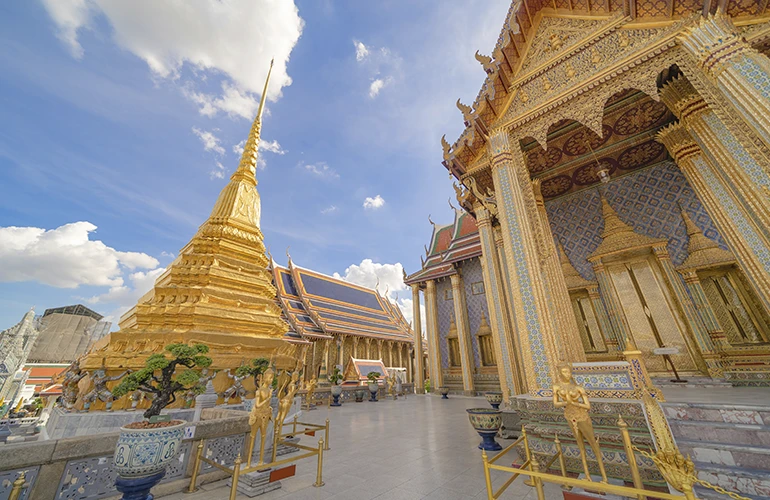
Golden pagoda at the Temple of the Emerald Buddha in Bangkok, Thailand.
5 curiosities of the Buddha temple:
- Not an inhabited temple: Unlike other Buddhist temples in Thailand, Wat Phra Kaew does not house monks. Its main purpose is to protect religious objects of great importance, such as the Emerald Buddha.x
- It features incredible murals: The outer walls of the temple are adorned with murals depicting scenes from the Ramakien, the Thai version of the Hindu epic Ramayana. These paintings, rich in details, tell stories of gods, demons and heroes.
- Saved by Yakshas: Around the temple you can see statues of Yakshas, guardian spirits of Thai folklore. These imposing guardians are placed at the doors and corners, protecting the temple from evil spirits.
- Model of Angkor Wat: inside the complex, there is a scale model of the famous Cambodian temple Angkor Wat. It was built by King Rama IV as a way to reclaim the cultural heritage of Angkor.
- A complex within a complex: Wat Phra Kaew is within the Grand Palace of Bangkok, serving as a royal chapel and site of religious ceremonies of great importance to the Thai monarchy.
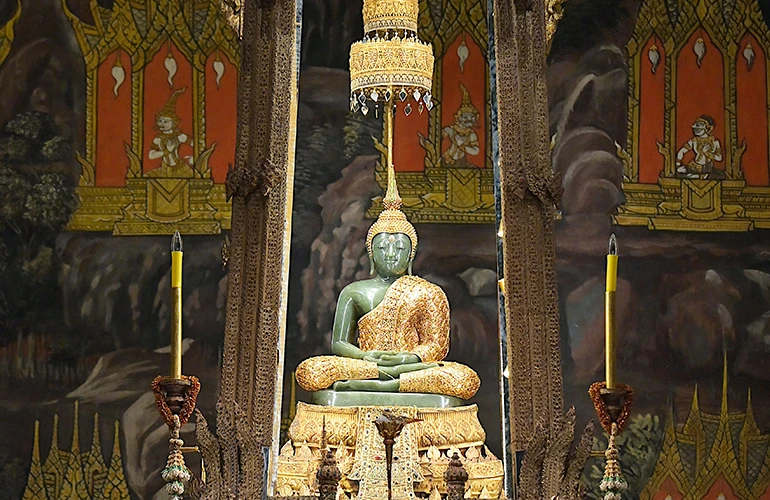
Closeup of emerald Buddha statue in meditation pose from Wat Phra Kaew, revered as the palladium of Thailand.
What is the origin of the Emerald Buddha?
At Thai Spa Massage we love Buddhas, and we have dedicated several more entries to them. The Emerald Buddha Shrouded in the veils of time and legends, the Emerald Buddha charts an epic journey that reflects the depth and richness of Buddhist spirituality. Created in the 1st century BC. By Venerable Nagasena in Pataliputra, present-day Patna, India, this sacred icon was forged following the teachings of the Buddha himself. After blessing the land of his creation for three centuries, fear of devastation from civil war led him to seek refuge on the serene island of Sri Lanka. However, fate had planned a tumultuous course for this emblematic sculpture.
In the year 457, King Anuruth of Burma requested the sacred Emerald Buddha. His request accepted, the return trip was marked by a storm that changed his destination, taking the Buddha to the coast of Cambodia. Through the centuries and between conquests, the Emerald Buddha traveled from Angkor Wat to Ayutthaya, passing through Kamphaeng Phet, Laos, and finally to Chiang Rai, where it was hidden, woven into the mystery of its true origin, which some experts in Art they suggest could be from the Lanna kingdom in the 15th century.
This extraordinary journey is not just the journey of a statue; It is the odyssey of a sacred symbol of faith, protection and wisdom that has gone through wars, storms and the passage of time, uniting nations under the mantle of Buddhism. Another story, much more legendary but well known, tells that it was found in 1434 in Chiang Rai, northern Thailand, when lightning struck a chedi (a pagoda-like structure) in a temple, revealing the statue inside a stucco. The statue was carried through several Thai kingdoms, finally ending up in Bangkok under King Rama I, who installed it in the Temple of the Emerald Buddha within the Grand Palace complex in 1784.
The exact age of the statue is debated, but it is believed that it could have been created in the 14th century. Despite its name, the Emerald Buddha (dressed in golden robes) is not made of emerald, but rather jadeite or, according to some sources, a type of green jade, highly valued materials that symbolize purity and durability.
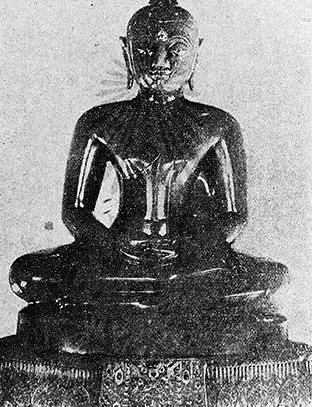
Captured image of the Emerald Buddha without ornaments, recorded in 1932.
How tall is the Emerald Buddha?
With a modest height of approximately 45 cm, this small but significant representation is distinguished by its meticulous craftsmanship and the detailed gold draperies that adorn it, reflecting the elevated status and respect in which it is held. The revered Emerald Buddha statue is an exceptional work of religious art and an object of deep spiritual devotion, depicting Gautama Buddha in a meditative pose.
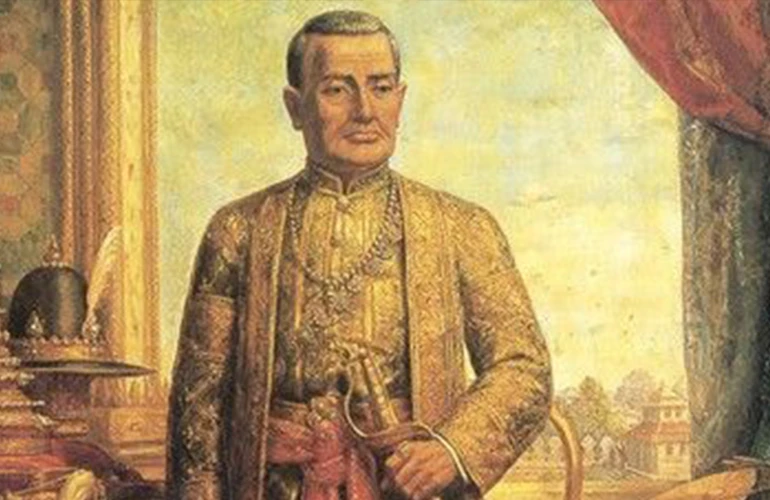
Portrait of King Rama I in the hall of the Grand Palace in Bangkok.
Was the Emerald Buddha stolen?
In 1779, the Siamese general Chao Phraya Chakri led a raid into Laos, capturing Vientiane and moving the Emerald Buddha to Siam. This valuable symbol was initially placed in a shrine near Wat Arun in Thonburi, which by then had become the new capital of Siam. Upon ascending the throne, Chao Phra Chakri began the Chakri Dynasty of the Rattanakosin Kingdom, later being known as King Rama I. This monarch relocated the capital to the other side of the Chao Phraya River, in present-day Bangkok, and there he erected the new Grand Palace, which would include Wat Phra Kaew within its walls. The latter was officially inaugurated in 1785, and it was then that the Emerald Buddha was solemnly relocated to its current location in the ubosot of the Wat Phra Kaew complex, during February or March 1785.
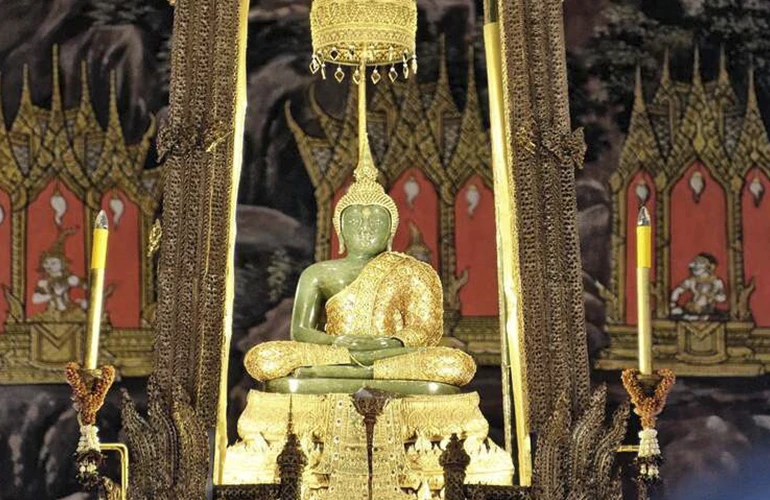
One of the most notable aspects of the Emerald Buddha is its clothing, as it has three different sets.
What ceremonies are held at the Temple of the Emerald Buddha?
The Emerald Buddha is distinguished by wearing three distinctive sets of gold ornaments, designed to mark the seasons of the year. Two of these sets were created by King Rama I, dedicated to the summer and rainy season, while a third set, intended for winter, was added by King Rama III. In a symbolic gesture for the Golden Jubilee of King Bhumibol Adulyadej in 1996, an exact replica of these ornaments was commissioned, funded entirely by voluntary contributions. The originals, more than two centuries old, have been removed from use and are now on display in the Temple of the Emerald Buddha Museum, located within the Grand Palace.
The ceremony of changing the seasonal decorations is carried out by the king of Thailand or a representative of the royal family, marking the change of the seasons in the lunar months of March, August and November. This ritual symbolizes the transition between the seasons and reinforces the spiritual connection of the Thai people with their monarchy and Buddhist traditions. Each set of clothing reflects the spirit and essence of the season it represents, from the exuberance of summer to the solemnity of winter, passing through the introspection of the rainy season.
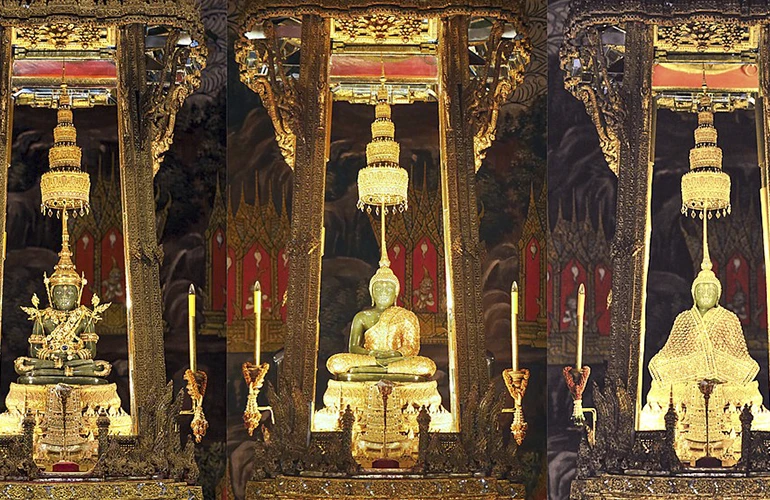
The Emerald Buddha, shown with its three seasonal decorations, from left to right: for the summer season, the rainy season and the winter period.
